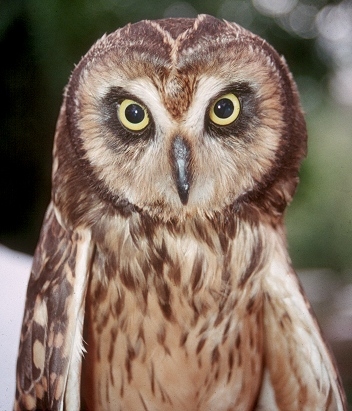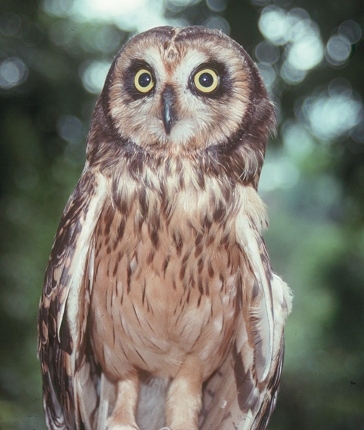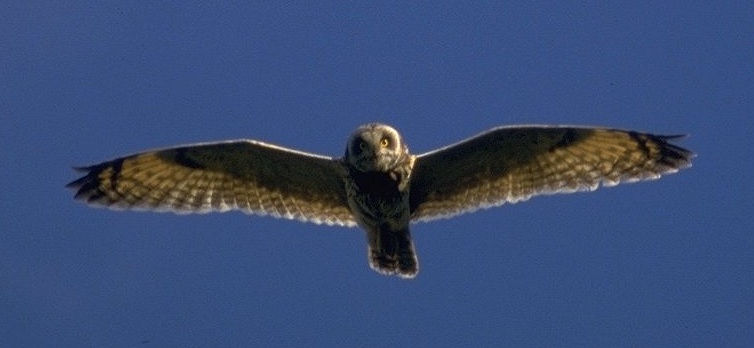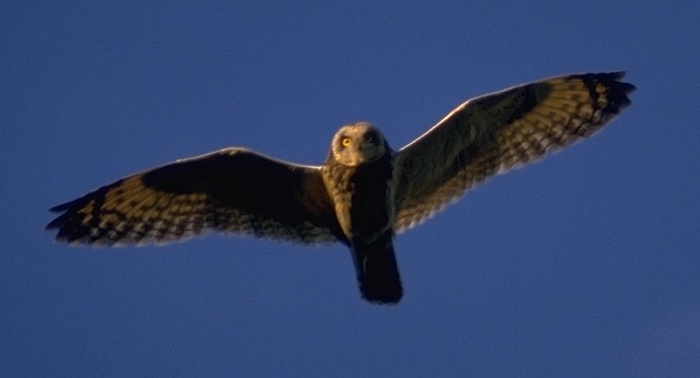|
Short-eared Owl Asio flammeus Múcaro Real,
|
 |
|
Photo: M. Oberle*
|
|
Short-eared Owl Asio flammeus Múcaro Real,
|
 |
|
Photo: M. Oberle*
|
|
IDENTIFICATION: The Short-eared Owl has a big-headed look, and flies on long wings that are lighter below, with a dark, comma-shaped mark on the forewing. Length: 34-42 cm.; weight: 325 g. VOICE: Calls include a series of raspy, barking notes. HABITAT: Open fields, pastures, marshes, and woodland clearings. HABITS: This owl has a deep, slow wing beat as it flies at dawn and dusk, low over grasslands in search of small mammals, lizards, and birds. It will also hover over a single spot, somewhat like a Kestrel, and will sometimes feed in daylight, unlike most other owls. When it eats small birds, it clips the wings off first. It is able to use both hearing and sight to locate prey. It regurgitates pellets of undigested bones and fur. Details of the nesting biology and behavior of the Antillean races of this species are not as well known as for North American populations: The female scrapes a nest in a dry ridge on the ground. The female incubates the 3-4 eggs and broods the young while the male brings food to her. The incubation period is about 26-37 days. Two weeks after hatching, the young leave the nest and walk around the grass nearby until they can fly at about five weeks. STATUS AND CONSERVATION: An uncommon, permanent resident in Puerto Rico. A century ago, this species was considered rare, and Wetmore, the pioneering ornithologist, thought it might have been near extinction. Conversion of forests and cane fields to grasslands probably helped this species, and they have become more common, even on university campuses such as at UPR/Humacao and Universidad del Turabo (Gurabo). The introduced mongoose, and the conversion of farmland to housing and other development are current problems for the species. Since Short-eared Owls fly low over open country, they are often the victims of collisions with cars and wires. RANGE: Breeds from northern Alaska south to central Mexico and on Cuba, Hispaniola and Puerto Rico. Regular locations to find this species are in open country near Salinas, Laguna Cartagena National Wildlife Refuge, and Caño Tiburones Nature Reserve. They have also been seen in open areas near some university campuses, e.g. Humacao and Universidad del Turabo (Gurabo). TAXONOMY: STRIGIFORMES; STRIGIDAE. The subspecies in the Caribbean, including Puerto Rico’s Asio flammeus portoricensis, have been suggested as a separate species (Asio dominguensis) from the North American population. Short-eared Owls in the Caribbean are smaller, have darker upperparts, and larger bills and feet. Their vocalizations differ, and the Caribbean subspecies have smaller clutches. A Great Horned Owl (Bubo virginianus, Búho Cornudo Americano) was photographed near Orocovis in December, 1994. It is much larger and darker than the Short-eared Owl. Since this North American species has never been documented elsewhere in the West Indies, the origin of this bird is doubtful. |
 |
|
Photo: M. Oberle*
|
 |
|
Photo: M. Oberle*
|
 |
|
Photo: M. Oberle*
|
 |
|
Photo: M. Oberle*
|
 |
|
Asio flammeus dominguensis of Hispaniola and Cuba - |
 |
|
North American Asio flammeus flammeus
- Photo: G. Dreameaux
|
 |
|
European Asio flammeus flammeus - Photo:
J. Hornbuckle
|
 |
|
European Asio flammeus flammeus - Photo:
J. Hornbuckle
|
 |
|
Photo: G. Beaton
|
|
References del Hoyo, J., A. Elliott, and J. Sargatal, eds. 1999. Handbook of the Birds of the World, Vol. 5. Barn Owls to Hummingbirds. Lynx Edicions, Barcelona. Garrido, O. H. 1995. A preliminary review of the Short-eared Owl Asio flammeus complex in the Greater Antilles. El Pitirre 8(3):8. Hoffman, W., G. E. Woolfenden, and P. W. Smith. 1999. Antillean Short-eared Owls invade south Florida. Wilson Bull. vol. 111, in press. Holt, D. W. and S. M. Leasure. 1993. Short-eared Owl (Asio flammeus). No. 62 in The birds of North America (A. Poole and F. Gill, eds.). Acad. Nat. Sci., Philadelphia, PA, and Am. Ornithol. Union, Washington, D.C. Norton, R. L. 1986. First record of Purple-throated Carib for the Greater Antilles and notes on vagrants in the Virgin Islands. Carib. J. Sci 22(3-4):462-463. Pérez-Rivera, R. A., Cotté-Santana, R., and L. Maldonado. 1977. El retorno del Múcaro Real (Asio flammeus portoricensis). Science-Ciencia 4(2):33-38. Raffaele, H.A. 1989. A guide to the birds of Puerto Rico and the Virgin Islands. Princeton. Raffaele, H.A. 1989. Una guía a las aves de Puerto Rico y las Islas Vírgenes. Publishing Resources, Inc., Santurce, PR. Raffaele, H.A., J.W. Wiley, O.H. Garrido, A.R. Keith, and J.I. Raffaele. 1998. Guide to the birds of the West Indies. Princeton. Rivera-Milán, F.F. 1995. Distribution and abundance of raptors in Puerto Rico. Wilson Bull. 107(3):452-462. Rolle, F.J. 1960. The Puerto Rican Short-eared Owl. Florida Naturalist 33:75-76, 82. Wetmore, A. 1927. Birds of Porto Rico and the Virgin Islands. New York Academy of Sciences Scientific Survey of Porto Rico and the Virgin Islands, IX: Parts 3-4, pp. 245-598. http://www.owlpages.com/species/shorteared/index.html Raptors in general in Puerto Rico: http://netdial.caribe.net/~falconpr/ Next related species in taxonomic order Previous related species in taxonomic order |